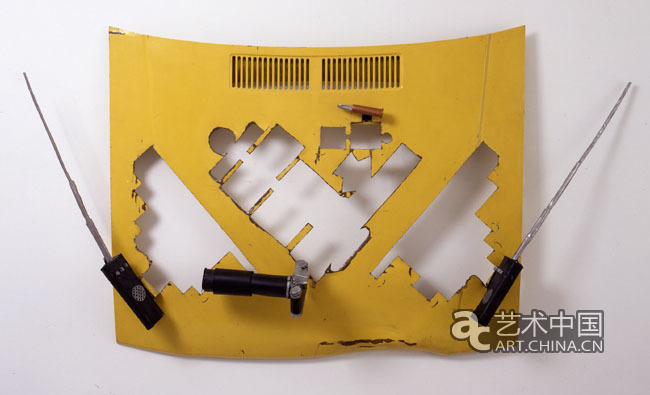比爾伍德羅-《遠道來的信息》 |
| 藝術中國 | 時間: 2010-01-29 18:40:46 | 文章來源: 藝術中國 |
|
比爾伍德羅 - 《遠道來的信息》 Bill Woodrow Long Distance Information 1983 Metal and mixed media 184 x 190 cm 比爾.伍德羅 遠道來的信息,1983 金屬和混合媒體 184 x 190cm
比爾?伍德羅的雕塑開始表現變形技藝,把日常物品轉換為新穎和具有高度創造性的作品。伍德羅與“新雕塑”主題下作品沒有多大聯系的其他藝術家(其中包括理查德?迪肯和托尼?卡拉格)一起,擺脫了20世紀70年代多數概念作品樸素和較少抽象的特征。里森畫廊將成為他們著手釋放華麗的表演場地,按理查德?科克的話說,這種華麗是“醉心于嫻熟的技能表現、異常的繁盛和大膽的幽默”,同時又“足夠地喧鬧,在年輕的藝術家中渲染了更多的情緒。”在找到自由探索各種現有物品和材料代表性品質的同時,他們的作品又有一種機智、娛樂和想象感,直面當代社會中令人不舒服的某些方面。 1981年,伍德羅展出了由一對黑傘構成的作品《烏鴉與腐肉》(Crow and Carrion)(1981年)。第一把傘破爛而褶皺,一塊兒傘布割出了一只胳膊的形狀,因此它看起來分成兩個維度,基本上就像是個影子。第二把傘給改成了落在裸露傘架上一只烏鴉。《烏鴉與腐肉》展示了伍德羅經常在其作品中建立的受害者與侵犯者之間的相互關系。傘也強調了超現實主義的傳統,以及弗洛伊德有關離奇和熟悉的去熟悉化觀點。然而,伍德羅的雕塑利用受到不景氣、裁員、憤怒和荒廢影響的國家殘留物,牢牢地根植于現在——所有的主題都與今天相關。 《長途信息》同《烏鴉與腐肉》一樣,也在今天提出了與當初創造時相關的問題。我們可以看到,一個車蓋被切割,制作出一副對講機,一個長焦相機和一顆子彈,制造出恐怖和監視的氛圍,這或許是受到1982年馬島戰爭(Falklands War)以及英國國內媒體大肆宣傳的影響。從今天看來,車蓋的黃色增添了一種新的含義:阿富汗和伊拉克沙漠。它就像用戶至上主義后方的壕溝藝術。盡管如此,這部作品決沒有爭議性- 它能激發想象,帶有異常叛逆的精神,能喚醒古老、厭倦和被拋棄的東西,重新為其注入熱情和幽默。車蓋變成了臨時用的帆布,帆布粗糙的切口幾乎刻畫出了用于住房建筑計劃的平面圖。伍德羅自己說,這部作品受到“田納西州孟菲斯”(1958年)中查克?貝里(Chunk Berry)極力要與人溝通的啟發: 長途信息,給予我田納西州孟菲斯 幫助我找到試圖與我聯系的一方 她可能不會留下她的號碼,但是我知道是誰打的電話 因為我的叔叔留下了信息,把它寫在了墻上 Bill Woodrow The sculptures of Bill Woodrow set about enacting feats of metamorphosis, turning everyday objects into new and highly inventive creations. Woodrow, together with othe artists whose work came to be loosely associated under the title ‘The New Sculpture’ (among them Richard Deacon and Tony Cragg), broke away from the austerity and reductive abstraction that characterised much of the conceptual work of the 1970s. The Lisson Gallery was to become a staging ground whereupon they could set about unleashing a flamboyance that was, in the words of Richard Cork, ‘revelling in showmanship, exotic flourishes and outrageous humour’, and at the same time ‘boisterous enough to inaugurate an expansive new mood among young practitioners’. Discovering a freedom to explore the representational qualities of various found objects and materials, their work had a sense of wit, play and imagination that held itself up directly to certain aspects of contemporary malaise within society. In 1981, Woodrow showed the work Crow and Carrion (1981) , comprising a pair of black umbrellas. The first is broken and crumpled, with a section of its fabric cut out in the shape of an arm, so that it appears in two dimensions, almost like a shadow. The second umbrella has been fashioned into a crow, which is pecking at the exposed limb. Crow and Carrion exhibits the interplay between victim and aggressor that Woodrow frequently establishes in his works. The umbrellas also highlight the legacy of Surrealism, and Freud’s ideas on the uncanny and the de-familiarisation of the familiar. Woodrow’s sculpture is, however, firmly rooted in the present, utilising the spat-out remnants of a country in the grip of recession, redundancy, anger and waste – all themes pertinent today. Long Distance Information, like Crow and Carrion, also raises questions that are as relevant now as they were when first made. We can see that a car bonnet has been cut out to create a pair of walkie-talkies, a long-lens camera and a bullet, evoking a climate of fear and surveillance, perhaps exacerbated by the Falklands War of 1982 and its long-range portrayal by the media back in the UK. Seen from the present day, the yellow of the bonnet adds a new connotation: the deserts of Afghanistan and Iraq. It is like trench art on the home front of consumerism. Nonetheless, this work is by no means polemical – it is imaginative, with a spirit of deviant inversion, resuscitating the old, tired and discarded, and injecting it with a new zest and humour. The bonnet forms a makeshift canvas, whose coarse incisions could almost be hacked-out plans for a Bauhaus housing scheme. Woodrow himself has said that this work was inspired by the Chuck Berry hit about striving for communication, ‘Memphis Tennessee’ (1958): Long distance information, give me Memphis Tennessee Help me find the party trying to get in touch with me She could not leave her number, but I know who placed the call ’Cause my uncle took the message and he wrote it on the wall |
| 注:凡注明 “藝術中國” 字樣的視頻、圖片或文字內容均屬于本網站專稿,如需轉載圖片請保留 “藝術中國” 水印,轉載文字內容請注明來源藝術中國,否則本網站將依據《信息網絡傳播權保護條例》維護網絡知識產權。 |
